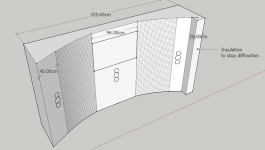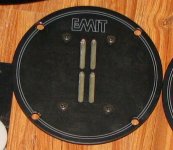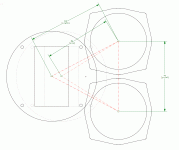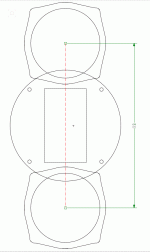mtm design using 2 Aurasound ns3 in sealed enclosure. Each driver gets 4 inch cube (as per Wolf's suggestion)
1) Benefit or drawback of shared enclosure vs separate?
2) More generally does putting an angled piece of wood at the back of the enclosure behind the driver, angled up (45 degrees) into polyfill reduce return of back-wave?
Thanks
Shawn
1) Benefit or drawback of shared enclosure vs separate?
2) More generally does putting an angled piece of wood at the back of the enclosure behind the driver, angled up (45 degrees) into polyfill reduce return of back-wave?
Thanks
Shawn
No. I'd still keep the enclosure common.
I drew up an MTM with RS40-1197 and some ribbons, and i ended up putting the ribbon beside the mid-basses.
I will often (actually all-the-time so far) move the tweeter off to the side to allow for as close as possible spacing. Up where you will have to be crossing it is even more critical. I'd you can trim the tweeter bezel to get things closer i would consider that too.
In an ideal world C-C spacing of the Aura would be 1/4 wavelength or less of the XO frequency. With a planar tweeter that is highly unlikely, but you do want as close as possible.
Note: 4" cube (internal) is about 1 litre/driver. I'd use at least 1.5 litre and given the high driver Q, as high as about 5 litre/driver. Above that one starts to have rapidly declining gains.
dave
I drew up an MTM with RS40-1197 and some ribbons, and i ended up putting the ribbon beside the mid-basses.
I will often (actually all-the-time so far) move the tweeter off to the side to allow for as close as possible spacing. Up where you will have to be crossing it is even more critical. I'd you can trim the tweeter bezel to get things closer i would consider that too.
In an ideal world C-C spacing of the Aura would be 1/4 wavelength or less of the XO frequency. With a planar tweeter that is highly unlikely, but you do want as close as possible.
Note: 4" cube (internal) is about 1 litre/driver. I'd use at least 1.5 litre and given the high driver Q, as high as about 5 litre/driver. Above that one starts to have rapidly declining gains.
dave
I went with separate volumes with mine. One of my morel MTM cabinets after flaring the woofer cutouts, and grinding - My Photo Gallery
Does complicate things. But getting the tweeter close is still possible.
Tony.
Does complicate things. But getting the tweeter close is still possible.
Tony.
Ok, off the top of my head...
With drivers on top and bottom of tweeter flange (5.75cm), once the waves hits me at 2.5m away won't it be acting as one wave regardless? (4k crossover)
Your suggestion is throwing a bit of a wrench in my design. haha. But I like it.
I attached an image of my baffle wall. The tweeters will be at ear level, in an equilateral triangle from listening position.
The middle baffle is flat, baffles with L R are also flat, conjoining baffles are circular.
The insulation will be on both sides. the total width is a bit of a silly number.
Just to give you an idea of what's going on.
With drivers on top and bottom of tweeter flange (5.75cm), once the waves hits me at 2.5m away won't it be acting as one wave regardless? (4k crossover)
Your suggestion is throwing a bit of a wrench in my design. haha. But I like it.
I attached an image of my baffle wall. The tweeters will be at ear level, in an equilateral triangle from listening position.
The middle baffle is flat, baffles with L R are also flat, conjoining baffles are circular.
The insulation will be on both sides. the total width is a bit of a silly number.
Just to give you an idea of what's going on.
Attachments
Last edited:
A single volume for both Ms with a very small diameter Neo dome tweeter is necessary for minimal lobing C-to-C physics. Zaph reviewed a few low cost domes. Any ideas for a thin front baffle? aluminum? 0.4" Baltic Birch?
ZAPH....
Vifa D26NC55 ($37) - Very smooth response with mild tilt down of a couple dB over it's range. Near perfect CSD without no high frequency garbage. *Very* low HD above 2.5kHz with a mild 3rd order peak at 1.6kHz. Almost a complete lack of tall order HD products. Well built small flange neo with heat sink and excellent internal construction.
--------
Dayton ND28F ($19) - This is a nice performing small flange neo tweeter. The harmonic distortion is relatively clean for this price range and the tweeter should be able to handle 2 kHz LR4 at reasonable levels. Sensitivity is low. The response curve looks good except for a high Qts low end bump that will need to be addressed in the crossover.
-----------
Dayton ND20FB ($8) - Very smooth, usable response. Nifty rear mount design. Good distortion performance above 3.5kHz. Super small and super cheap but definitely usable. Note that this "F" version has ferrofluid.
-------------
Biro Technology
Vertically Symmetric Two-Way Loudspeaker Arrays Reconsidered
ZAPH....
Vifa D26NC55 ($37) - Very smooth response with mild tilt down of a couple dB over it's range. Near perfect CSD without no high frequency garbage. *Very* low HD above 2.5kHz with a mild 3rd order peak at 1.6kHz. Almost a complete lack of tall order HD products. Well built small flange neo with heat sink and excellent internal construction.
--------
Dayton ND28F ($19) - This is a nice performing small flange neo tweeter. The harmonic distortion is relatively clean for this price range and the tweeter should be able to handle 2 kHz LR4 at reasonable levels. Sensitivity is low. The response curve looks good except for a high Qts low end bump that will need to be addressed in the crossover.
-----------
Dayton ND20FB ($8) - Very smooth, usable response. Nifty rear mount design. Good distortion performance above 3.5kHz. Super small and super cheap but definitely usable. Note that this "F" version has ferrofluid.
-------------
Biro Technology
Vertically Symmetric Two-Way Loudspeaker Arrays Reconsidered
I'm planning to use HDF either 1/8" or 1/4" possibly 2 layers green glued. The drivers are not rigidly mounted to the baffle wall but will be magnet braced using abs pipe, filled with sand and light filler to heavy damped platforms on the floor.
Those domes look like good options, what's holding me back is I have 3 Infinity Emit tweeters at my disposal. I really do like the Emits....
The goal here is highly directional and low cost. Hence the driver choices, which just happen to be drivers I have kicking around. But if these drivers are going to cause issues in mtm arrangement then my mind may be changed. Also ease of crossover design may sway me.
Those domes look like good options, what's holding me back is I have 3 Infinity Emit tweeters at my disposal. I really do like the Emits....
The goal here is highly directional and low cost. Hence the driver choices, which just happen to be drivers I have kicking around. But if these drivers are going to cause issues in mtm arrangement then my mind may be changed. Also ease of crossover design may sway me.
Last edited:
Attachments
This is what i had in mind… if you are willing to make some new mounting holes (grey dotted EMIT) then you can get 925 Hz = 1/4 wavelength.
Mirror image L & R
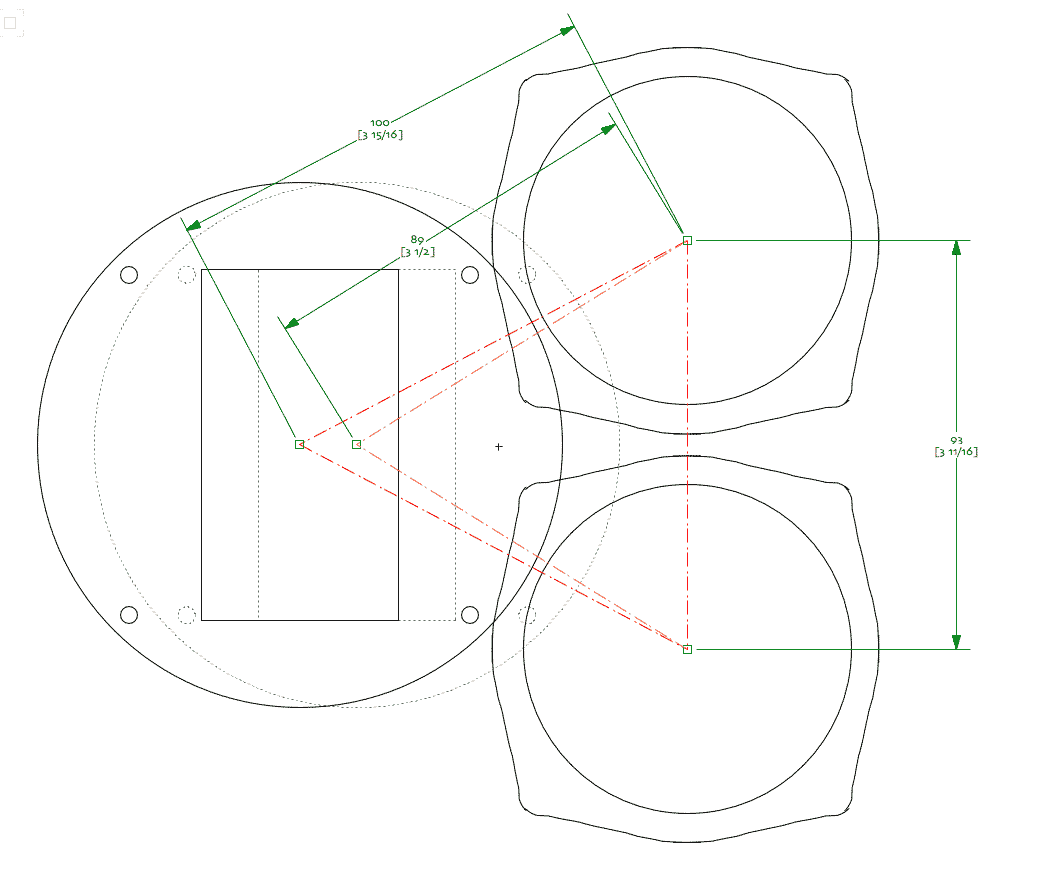
Straight up centre -- 485 Hz = 1/4 wl.
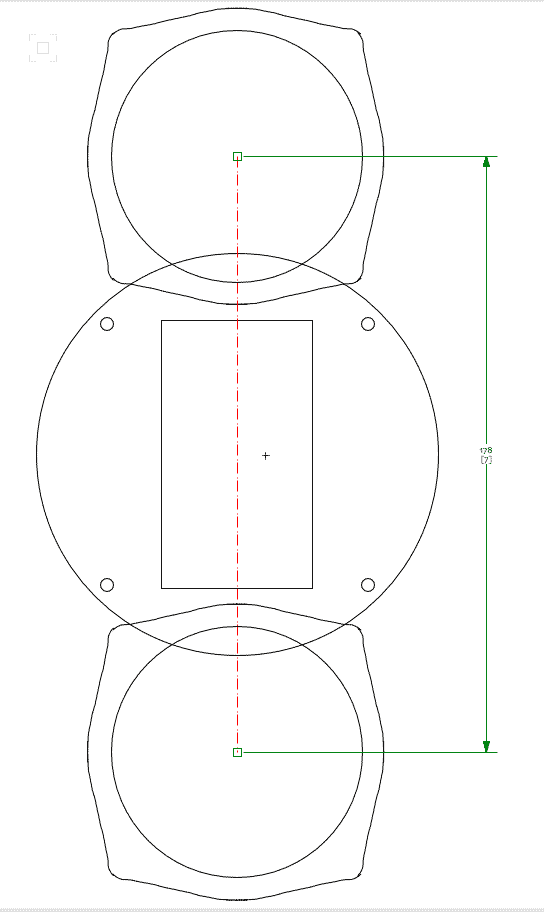
How low can you XO the EMIT?
dave
Mirror image L & R
Straight up centre -- 485 Hz = 1/4 wl.
How low can you XO the EMIT?
dave
Attachments
Very interesting. I could modify the bezel with the laser cutter.
As far as I'm aware Infinity didn't cross any of these lower than 4k, 2nd order. 3.7k isn't a heck of a lot lower....
Here's this though, diffraction. Infinity conveniently made the bezel very close to the 4k wavelength, no edge diffraction for this tweeter.
What do you think?
Edit: I probably won't need to cut them. Aligning voice coils will put the tweeter behind the drivers anyways, which are not rigidly mounted to the front baffle.
As far as I'm aware Infinity didn't cross any of these lower than 4k, 2nd order. 3.7k isn't a heck of a lot lower....
Here's this though, diffraction. Infinity conveniently made the bezel very close to the 4k wavelength, no edge diffraction for this tweeter.
What do you think?
Edit: I probably won't need to cut them. Aligning voice coils will put the tweeter behind the drivers anyways, which are not rigidly mounted to the front baffle.
Last edited:
With bezels flush there is ~3-4mm difference in 'acoustic centers' The Aura is more recessed. I'm not sure if this is even worth considering or not.
And let me get this straight. When I am listening ~2.5m from speakers, on axis. Lobing can still occur? I was of the belief that the wave front integrated at that distance...
And let me get this straight. When I am listening ~2.5m from speakers, on axis. Lobing can still occur? I was of the belief that the wave front integrated at that distance...
Last edited:
I could modify the bezel with the laser cutter. As far as I'm aware Infinity didn't cross any of these lower than 4k.
Lasers? A few dome tweeters only need a drill hole for mounting.
It's worth the time to run a MTM simulation with one of the $10-$20 small diameter neo dome tweeters and a 2.4-3kHz Xover before you fire-up the laser. Passive Xover parts will be more expensive than the dome.
Xdir a 2 minute tool. The MTM polars for a 2.4Khz Xover is already marginal.
Baffle Diffraction is a 15 minute tool.
BoxSim is a 15 minute tool after 45 minutes training.
That's bad.Aligning voice coils will put the tweeter behind the drivers anyways, which are not rigidly mounted to the front baffle.
Drivers (woofers) should be one body with the enclosure
- Status
- This old topic is closed. If you want to reopen this topic, contact a moderator using the "Report Post" button.
- Home
- Loudspeakers
- Multi-Way
- mtm seperate or shared enclosure
